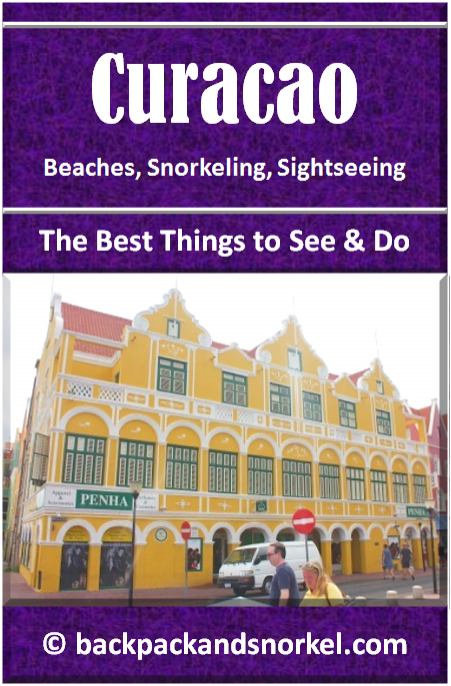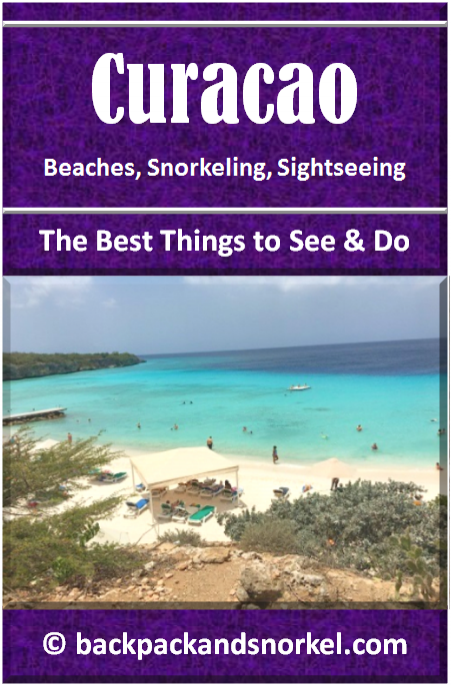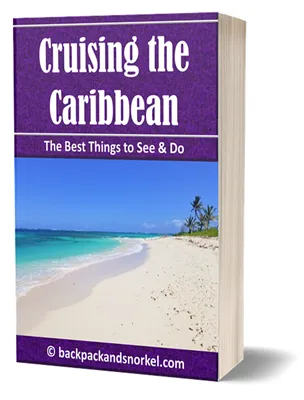Travel Guide for a Cruise to Curacao - Curacao Purple Travel Guide
Curacao is known for its colorful houses, the blue Curacao liquor, beautiful white sand beaches and incredibly turquoise waters. We show you the best things to see and do and provide lots of photos so you understand what you will see when you visit Curacao.
The information on this page and much more (google maps locations, more reviews, website links, etc.) is available in our Cruising the Caribbean Guide.
If you are new to cruising, please check out Rudy's Cruise Guide for Beginners & Others.
Table of contents
General Information about Curacao |
Climate of Curacao |
Self-guided walking tour of Willemstad |
Playa Porto Marie in Curacao |
Street Art in Curacao |
General Information about Barbados
Curacao is an island 40 miles (65 km) North of Venezuela and below the hurricane belt. It used to be part of the Curacao and Dependencies colony (1815–1954) and with the dissolution of the Netherlands Antilles in 2010, Curacao became a country within the Kingdom of the Netherlands and is now officially called the “Country of Curaçao”. The population is above 160,000.
The Arawak people, who were believed to have migrated from the Amazon Basin, were the first inhabitants of Curacao. In 1499, members of a Spanish expedition were the first Europeans to see the island.
The origin of the name Curacao is not clear. The most likely explanation is that the indigenous people on the island identified themselves the Curacao.Another interesting explanation is that in the 16th and 17th centuries, sailors on long voyages would get deprived of vitamin C. Apparently, some Portuguese sailors who were ill were left at to heal at the island that is now Curacao. Upon return of their ship, they had recovered, probably after eating lots of fruits with vitamin C. The Portuguese then started referring to this as island as “Ilha da Curação” (Island of Healing).
Curaçao had been ignored by colonists for quite some time, because it lacked gold.
The capital city of Willemstad was founded by the Dutch West India Company. As it turned out, the natural harbour of Willemstad proved to be a great spot for trade and piracy. Willemstad also became a center for slave trade.
A major slave revolt took place in 1795 where up to 4000 slaves revolted. It took the slave owners about a month to suppress the revolt.
In the 18th and 19th centuries, Curacao changed hands a few times between the British, French and Dutch. In 1815, the island got under Dutch control again and was incorporated into the colony of Curaçao and Dependencies. Slavery was abolished in 1863.
The colorful houses, which are now a tourist attraction and helped make parts of Willemstad a UNESCO World Heritage site, began by then Governor-General Albert Kikkert passing a law that required all houses being painted in another color than white. He claimed he was plagued by recurring migraine headaches, which were aggravated by the sun’s brilliant reflections off the predominantly white buildings. Even though it was later discovered that Kikkert was a shareholder of the island’s only paint store, the tradition of having colorful buildings has lived on and have made Curacao’s Dutch and Spanish colonial architecture one of the most recognizable sights in the Caribbean.
Climate of Curacao
Curacao has a hot tropical semi-arid climate all year round. October through December see the highest rainfall, but the actual amount varies from year to year and is strongly influenced by the El Nino phenomenon. The temperature between night and day is larger than the temperature difference between summer and winter. Because hurricane lies south of the hurricane belt and is generally not hit by hurricanes. The last hurricane that hit Curacao was in 1877.
The average temperatures and rainfall that you can expect during your visit are shown here:


Self-guided walking tour of Willemstad

- Cruise Port
- Rif Fort
- Queen Emma Bridge
- Pastel colored houses of the Punda waterfront
- Heerenstraat
- Keukenstraat
- Queen Wilhelmina Park
- Mikvé Israel-Emanuel Synagogue
Close to the cruise port in Willemstad's Otrobanda neighborhood is the Rif Fort, which is a 19th-century fortress that was built at the entrance of the St. Anna Bay to protect Curacao from pirates and other enemies. It has 5ft (1.5m) thick coral walls and used to have 56 cannons. Today, Rif Fort is a trendy tourist attraction with restaurants, bars and live entertainment.
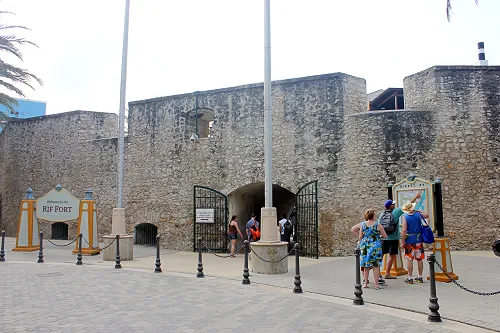
Walk towards the floating Queen Emma Bridge and enjoy the view of the pastel colored houses of the Punda waterfront on the opposite side of the river. When we first walked to the floating Queen Emma Bridge (also called “The Swinging Old Lady”) we were surprised as we did not see it. The reason is that it was reeled in to allow ships to pass. After waiting a few minutes, the bridge was moved back in place and we crossed it to get to Punda. This is also a good place to admire the huge Queen Juliana Bridge from afar.
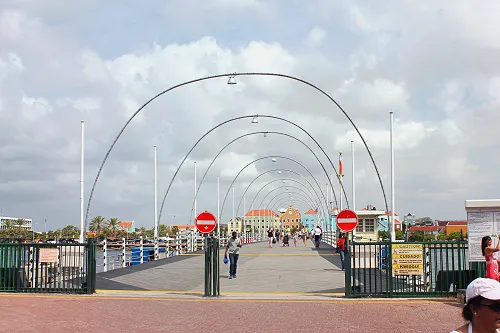
On the Punda side, enjoy the pastel colored houses along the waterfront. Then venture into the side streets and up and down Heerenstraat and Keukenstraat to see more painted houses, many stores and wall painted street art.




One point not to be missed is Queen Wilhelmina Park with the huge CURACAO and DUSHI letters. DUSHI has many meanings which vary a little on how the word is used. As a catch-all phrase it is used to describe “all the good stuff”. More specifically, it can mean “dear” or “sweetheart” or, to describe food, it means “delicious”.

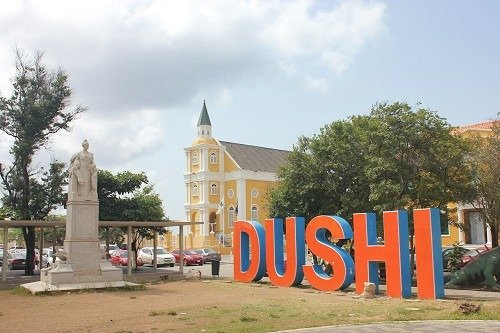
If you have time, visit the Mikvé Israel-Emanuel Synagogue which dates back to 1732 and is the oldest continually-used synagogue in the Americas.
Playa Porto Marie in Curacao
Playa Porto Marie is one of the best beaches that I have ever been to. Admission is $3 per person; renting beach chairs is, I believe, $3.50 per chair. The sand is white and has stones and coral pieces mixed in with it. The water is turquoise and very good for swimming and snorkeling. There is a bar/restaurant and there are restrooms.
It is a little difficult walking into the water over the stones and coral pieces in some areas. Once you are a few feet in the water, the sand is nice to walk on.
If you don’t like to walk on coral pieces, you can either bring water shoes or use the pier, which has a ladder at the end, to get into the water.
There is also a swimming platform if you want to sunbathe in the middle of the water.
Snorkeling is very good; we saw some scuba divers, so I assume there is good diving, too. We saw some fish that I have never seen in other places in the Caribbean. When you get there, you will be blown away by the view from the parking lot – it looks just like paradise.
Playa Porto Marie is a comparably small beach, so it can be crowded when there are several cruise ships in port.
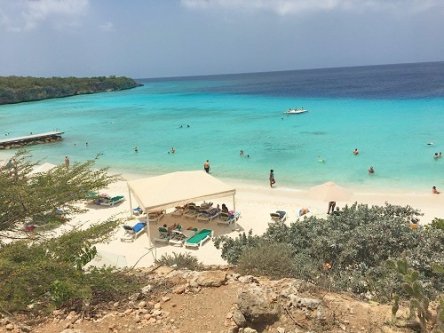
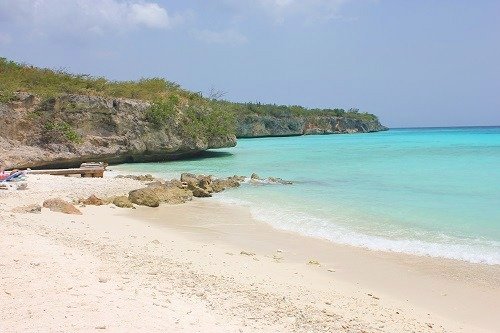


Street Art in Curacao
Did you know that Curacao has lots of beautiful Street Art? And best of all, much of it can be found in Otrobanda, not too far away from the cruise port.
ARE YOU INTERESTED IN MORE WHITE SAND BEACHES AND TURQUOISE WATER DESTINATIONS?
Check out our reviews of other Caribbean islands and Rudy's Cruise Guide.

Other popular Purple Travel Guides you may be interested in:
Like this Backpack and Snorkel Purple Travel Guide? Pin these for later:


